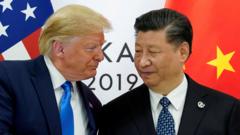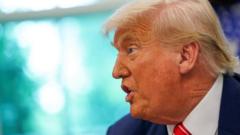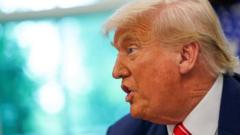Rutte's ambitious proposal requires member nations to commit 5% of their GDP to defense, a significant increase from the current 2% target, to strengthen transatlantic relationships and address security concerns.
**NATO Chief Pushes for Bold 5% Defense Spending Proposal Ahead of Summit**

**NATO Chief Pushes for Bold 5% Defense Spending Proposal Ahead of Summit**
As NATO leaders prepare for the impending summit, Secretary General Mark Rutte seeks to meet Donald Trump's demands for increased military expenditures.
In anticipation of the upcoming NATO summit, Secretary General Mark Rutte is keen on presenting a strong defense spending plan that aligns closely with the expectations of former U.S. President Donald Trump. The controversial leader, during his presidency, criticized NATO allies for their insufficient defense budgets, asserting that they were unfairly benefiting from U.S. contributions.
At a press conference held in Brussels, Rutte put forth a bold proposal that calls for NATO member countries to allocate 5% of their gross domestic product (GDP) towards military spending. This significant leap from the current goal of 2% could be an attempt to secure favor with Trump, whose transactional view of international relations places pressure on allies to significantly bolster their contributions to collective security.
Rutte acknowledges that meeting this ambitious goal will be challenging for many European countries. Questions remain about whether this defense increase is purely strategic for deterring Russia or if it also aims to appease U.S. expectations.
To provide some leeway, Rutte introduced a compromise where member nations would increase core defense spending to 3.5% of GDP, with the remaining 1.5% allocated for "defense-related expenditure." This ambiguous term would allow nations to count various costs, including infrastructure and industrial support, towards their commitments.
While the U.S. budget for defense stands at 3.4% of GDP, Rutte asserts that Washington will also adopt this new target. The prospect of compliance, however, raises concerns. Neither a strict timeline nor enforceable sanctions exist for NATO members failing to meet the defense spending commitment.
Moreover, despite commitments made over the past decade to reach the earlier 2% target, numerous countries have yet to fulfill their promises. Rutte insists he has a plan to ensure accountability—political leaders must present annual progress reports demonstrating incremental increases in spending for NATO member nations to stay on track towards the ambitious 5% target.
Rutte aims to visit the United Kingdom next week for discussions with Prime Minister Sir Keir Starmer. The current UK defense strategy involves a planned expenditure of 2.5% of GDP by 2027, with hopes of progressively increasing it to 3%.
U.S. Defense Secretary Pete Hegseth expressed confidence that several NATO allies, including France, Germany, Poland, Hungary, and the Nordic and Baltic nations, are already on board with the 5% proposal. Although not disclosing names of those lacking commitment, Hegseth believes that the UK, among others, will ultimately rise to meet the challenge.
At a press conference held in Brussels, Rutte put forth a bold proposal that calls for NATO member countries to allocate 5% of their gross domestic product (GDP) towards military spending. This significant leap from the current goal of 2% could be an attempt to secure favor with Trump, whose transactional view of international relations places pressure on allies to significantly bolster their contributions to collective security.
Rutte acknowledges that meeting this ambitious goal will be challenging for many European countries. Questions remain about whether this defense increase is purely strategic for deterring Russia or if it also aims to appease U.S. expectations.
To provide some leeway, Rutte introduced a compromise where member nations would increase core defense spending to 3.5% of GDP, with the remaining 1.5% allocated for "defense-related expenditure." This ambiguous term would allow nations to count various costs, including infrastructure and industrial support, towards their commitments.
While the U.S. budget for defense stands at 3.4% of GDP, Rutte asserts that Washington will also adopt this new target. The prospect of compliance, however, raises concerns. Neither a strict timeline nor enforceable sanctions exist for NATO members failing to meet the defense spending commitment.
Moreover, despite commitments made over the past decade to reach the earlier 2% target, numerous countries have yet to fulfill their promises. Rutte insists he has a plan to ensure accountability—political leaders must present annual progress reports demonstrating incremental increases in spending for NATO member nations to stay on track towards the ambitious 5% target.
Rutte aims to visit the United Kingdom next week for discussions with Prime Minister Sir Keir Starmer. The current UK defense strategy involves a planned expenditure of 2.5% of GDP by 2027, with hopes of progressively increasing it to 3%.
U.S. Defense Secretary Pete Hegseth expressed confidence that several NATO allies, including France, Germany, Poland, Hungary, and the Nordic and Baltic nations, are already on board with the 5% proposal. Although not disclosing names of those lacking commitment, Hegseth believes that the UK, among others, will ultimately rise to meet the challenge.




















